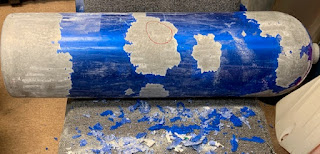Artificial Reefs: Reborn by Nature
 |
| The Christ of the Abyss statue in Pennekamp State Park celebrates Jesus Christ and provides substrate for sea life Photo: Tara McNaylor |
Instructor and Technician
fred@bubblesornot.com
Perceptions persist that wreck diving is deep, cold, boring and bereft of color. In this two-part series we explore artificial reefs and wrecks. Artificial reefs are manmade structures purposefully planted on the seafloor to provide marine habitat, relieve pressure on natural reefs, and to provide playgrounds for divers. Wrecks are ships or structures that met their fate through storms, collisions, sabotage or war at sea.
ARTIFICIAL REEFS
Bleaching, storms and overuse take their toll on reefs. Given time they will recover. However, building artificial reefs is an alternative method of providing more sea life habitat which creates underwater playgrounds. Think of an artificial reef as manmade substrate that Mother Nature populates with turtles, fish, molluscs, mammals, anemone and plants. These elements comprise ecosystems. These decommissioned objects are, in effect, reborn, taking on new life as the sea embraces them.
What comes to mind when you think of an artificial reef? Usually a ship that's been cleaned of toxic materials and sunk with fanfare. Concrete objects like slabs, jacks and pipes; decommissioned oil rigs; subway cars; military tanks and airplanes also have been used to make interesting reefs. They are as varied as natural reefs in size, location, depth, water temperature and aqautic residents. Let's sample some artificial reefs starting in our own backyard.
Georgia
Clark's Hill Lake (Lake Thurmond) has a twin-engine airplane at 30' (9m) that provides interest to a local dive and a stable platform for scuba training. Lines and good navigation skills will take you to over a dozen other features, natural and manmade. Local diver Andy Davis has painstakingly documented these features in an accurate site map. Using Andy's cartography as a guide, how many objects can you find at this unique CSRA dive site?
Florida
 |
| Bob Bennett wraps up his deco obligation on a rebreather wreck dive. Photo: A BoN diver |
The Sunshine State has an aggressive artificial reef building program with scores of reefs shallower than 60' (18m) down to 300' (90m). Scuba diving offers adventurous souls the opportunity to see exotic sea life in its natural environment. No sane person would jump into a lion exhibit at the local zoo and yet divers regularly encounter apex predators in the ocean. How fortunate we are!
- Pensacola is home to WWII-era Liberty ships, barges, aircraft and the USS ORISKANY (CV-34), the largest diveable aircraft carrier in the world.
- Florida Keys are home to impressive ships like the Vandenberg, Bibb, Duane, and Eagle with structure from 60' (18m) to 130' (40m). Even statues provide substrate as you can see from the growth on Christ of the Abyss.
California
San Diego's Wreck Alley contains numerous intentionally-sunk ships such as Her Majesty's Canadian Ship (HMCS) Yukon, a 366-foot long destroyer. Each ship has a story, a history of her crew, their patrols and adventures on the high seas.
Louisiana
 |
| Louisiana Department of Wildlife has overseen a vigorous artificial reef program since 1986 Graphic: State of Louisiana |
People dive in Louisiana? Yes they do, sugar! The Pelican state boasts the largest artificial reef in the world consisting of 29 structures of bridgework. Overall the state has hundreds of divable sites thanks to its Artificial Reef Program, one component of which is Rigs to Reefs that converts decommissioned oil rigs to artificial reefs. These massive structures provide shelter for sealife and playgrounds for fishermen and divers.
But I like Pretty Fish and Coral!
We all do. There is a lot of pressure on natural reefs from overfishing to over visiting. I guarantee that established artificial reefs will dazzle you with the variety of sea life attached to and residing there. As with a natural reef, their growth starts with small creatures and plants that grow and attract ever larger predators up to jacks, barracudas and sharks. Take a look for yourself.
Coming in October 2019
Wrecks: Great Diving from Mayhem



Comments
Post a Comment